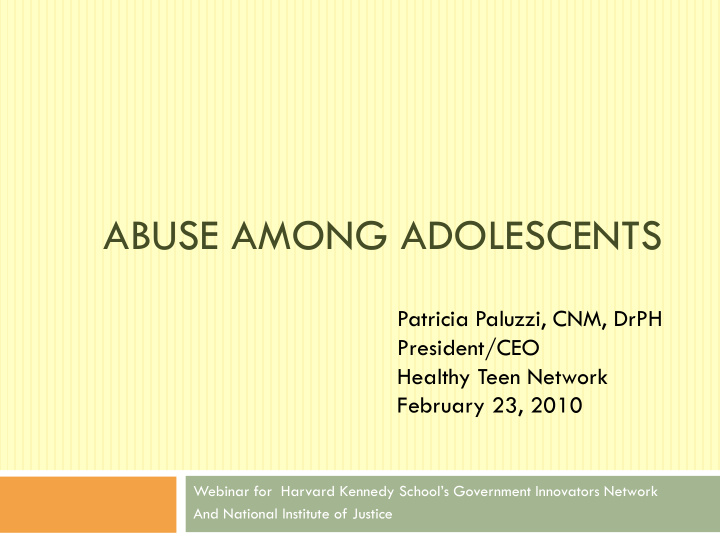



ABUSE AMONG ADOLESCENTS Patricia Paluzzi, CNM, DrPH President/CEO Healthy Teen Network February 23, 2010 Webinar for Harvard Kennedy School’s Government Innovators Network And National Institute of Justice
Abuse among Adolescents: The Facts � Research indicates that adolescents and young adults experience the highest degree of intimate violence of any age group and that, as a sub-group, young women ages 16-24 are most likely to be victimized (FVPF, 2004) � Among these women, teen mothers are especially vulnerable � In one study, teen mothers reported IPV rates of 27% compared to 15.9% of adult women (Rosewater, 2003)
Abuse among Adolescents: The Facts � Poverty, past abuse, low education, and isolation also contribute to intimate violence among teen mothers � Teens and young mothers can be simultaneously abused by family members and intimate partners � Policies, such as housing stipulation attached TANF, may perpetuate violent living situations for these vulnerable mothers.
Abuse among Adolescents: The Consequences � Increased unintended pregnancies, HIV and STIs � Increase rates of depression and suicide thoughts � Increased use of cigarettes, alcohol and other drugs � Youth experiencing child and family abuse, as well as IPV in their family of origin, will be impacted well into adulthood � Abused teen parents may be less able to parent effectively, feeling withdrawn from their children, thus perpetuating a cycle
Abuse among Adolescents: Specific Challenges � Dating violence may be just one issue among many that pose more imminent danger and challenges for our most marginalized youth; families, communities may pose violent threats � Condom negotiation in the presence of an abusive relationship is particularly challenging � Pregnant and parenting teens have similar relationship dynamics as adults but fewer skills � There are higher rates of IPV with unintended pregnancy— few teen pregnancies are intended. � Pregnant and parenting teens may be very isolated; have housing issues related to TANF that force them to stay in abusive situations
Abuse among Adolescents: Specific Challenges � Teens can think possessive behavior means “he/she loves me” � Challenging to address needs of all youth with one curriculum/intervention � Technology presenting new and rapidly changing means to control a partner’s behavior or sexually abuse them through “sexting” and the like
The Latest Abuse--Technology � One in four teens in a relationship say they have been called names, harassed or put down by their partner through cellphones and texting. � One in five teen girls and one in ten younger teen girls (13 to 16) have electronically sent or posted nude or semi-nude photos or videos of themselves. Even more teen girls, 37 percent, have sent or posted sexually suggestive text, email or IM (instant messages). � More than half of teen girls (51 percent) say pressure from a guy is a reason girls send sexy messages or images, while only 18 percent of teen boys say pressure from a girl is a reason. Twelve percent of teen girls who have sent sexually suggestive messages or images say they felt “pressured” to do so.
Abuse among Adolescents: Other marginalized populations � Marginalized populations of youth are at greater risk for abuse and generally have fewer resources available to them. � LGBTQ youth scared of being ‘outed’, not taken seriously � Homeless and runaway youth staying somewhere that isn’t safe out of necessity � Trading sex for sustenance, etc. � Where do we find these youth? � What kind of resources and supports are available?
Abuse among Adolescents: Our Approach � Age appropriate � Strictly confidential—don’t assume family members are “safe”, e.g. give pregnancy test results in private � Understand policies that affect this population � Know resources in your community � Context, context, context
Abuse among Adolescents: Our Response � Assure confidentiality, be non-judgmental and empathetic � Have current information for referral agencies and community resources � Conduct danger assessment and safety planning � Consider using the Stages of Change model as your guide, i.e. establish realistic goals for each intervention that move the young person toward taking action
Resources � Interpersonal Violence and Adolescent Pregnancy: Implications for Practice and Policy � Boys will be Boys: Understanding the Impact of Child Maltreatment and Family Violence on the Sexual, Reproductive, and Parenting Behaviors of Young Men � Widening Our Lens: A Comprehensive Strategy to Address the Impact of Child Maltreatment, Interpersonal, and Family Violence on Youth � All available at HealthyTeenNetwork.org
Recommend
More recommend